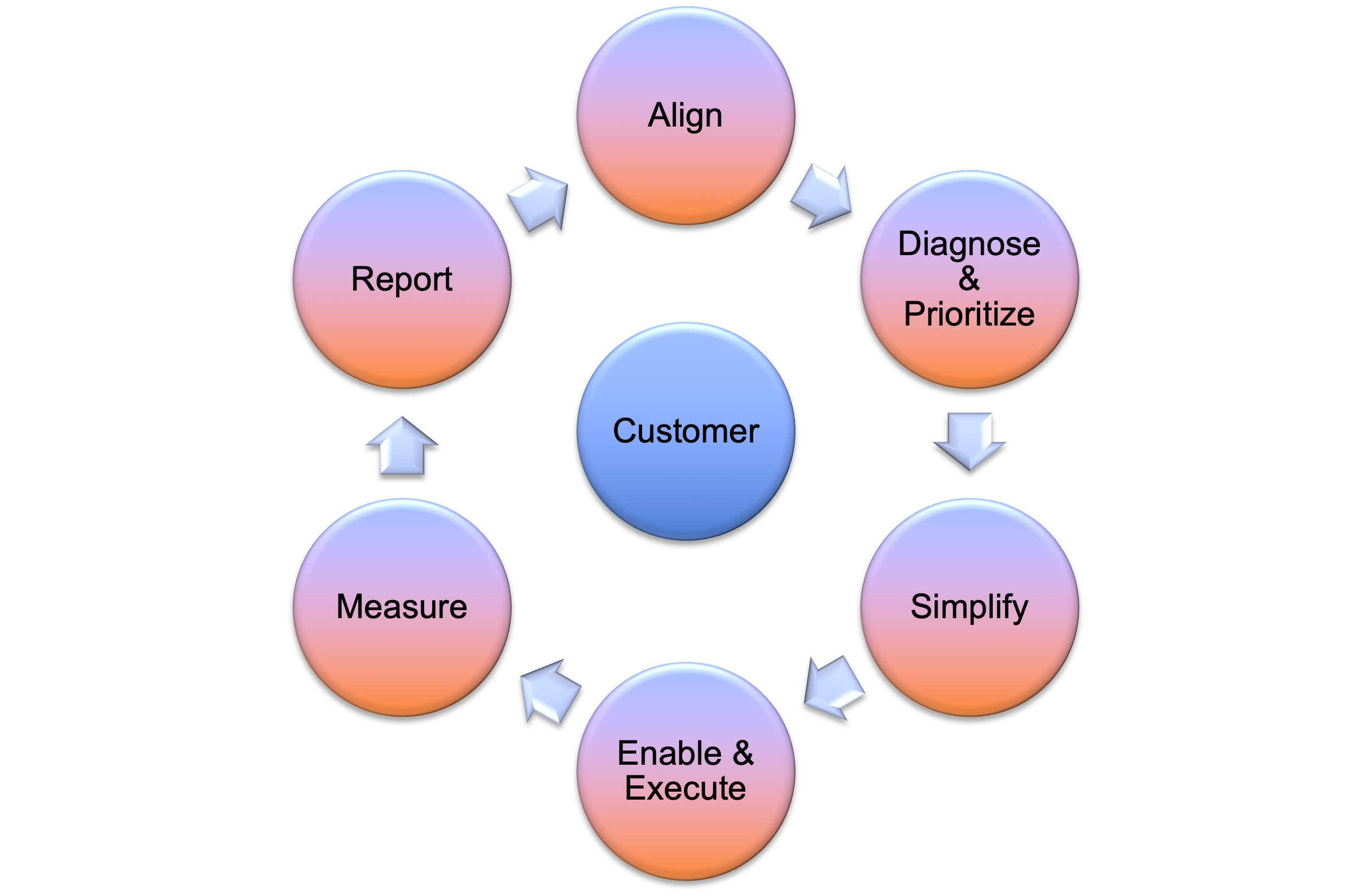
Our Approach
We Apply Our Unique Customer-Centric Methodology to Ensure a Successful Outcome
-
We’ll help you ensure alignment to top-level company objectives, assess org structures, attain Board and C-level buy-in, help you form alliances cross-functionally, and get agreement on a shared plan.
-
We apply clinical expertise with customer success in mind across the entire customer journey, from sales to support, in order to diagnose and prioritize the most painful challenges.
-
An often missed step, we will help you deconstruct and distill activities, refine roles and responsibilities, build a cross-functional RACI, and establish clear expectations on goals (from X to Y by Z).
-
This is where the rubber meets the road. It’s all about driving new Individual Contributor (IC) behavior by providing strong and effective enablement, helping leaders win the team over, inspiring as to the “Why”, and painting a vision for the future.
-
We must re-enforce a culture of accountability via visible and dynamic scorecards so every IC and leader can quickly determine if they are winning or losing based on precise KPIs, focusing on metrics that matter the most.
-
Lastly, we’ll help you setup a framework to over communicate what’s working, what’s not, what interventions or adjustments are in play, and celebrate success frequently.
REVEAL Framework ™️
We have a different take on the typical customer lifecycle. We believe efficient revenue extraction begins during the sales cycle with a Running Start before and during onboarding, ensuring proper Executive Engagement, and driving toward Expansion and Customer Advocacy with immediate focus on Value Creation. Then you must take the Learnings of each new customer and optimize for a more Lean process and experience for you and your next customer.
-
What companies too often do is conduct a sales-to-services handoff, have a welcome and kickoff call with the customer, leave it to a project team to complete the onboarding checklist, and several weeks or months later, prematurely celebrate the project sign-off. That then leads to another handoff to the CSM team. Nailing the handoffs is vital but customers don’t care about your handoffs and regularly see them as a nuisance. In fact, most companies fail to maintain the exciting momentum of the new partnership with the customer by imposing an often inefficient and anticlimactic onboarding experience. Sadly, onboarding is also one of the biggest obstacles to scale, requiring too much time and effort on the Proserv team or the customer. This is precisely where churn originates. But if done right, it’s also where expansion opportunities accelerate. We’ve transformed the new customer experience and call it a Running Start instead of Onboarding. It resonates with an exciting sense of urgency with customers, holds you accountable to actually delivering a “running start,” and doesn’t carry the negative connotations of traditional onboarding. While you may not be able to improve product self-service capabilities immediately, you can optimize this critical phase by starting the customer’s onboarding journey in the sales cycle, with the promise of fast first success. It requires simplifying and prescribing an approach that will ensure efficient value creation. It also demands alignment with Sales and Marketing on messaging along with some confidence-boosting pre-configuration assessments, and collaboration with Product to identify low-effort high-impact improvements that will impact time-to-value.
-
Most companies jump straight into the Adoption phase as soon as the onboarding steps are completed. It makes perfect sense because driving product adoption is a leading indicator of value, and is your primary anecdote to future churn. Meaning, if the customer is adopting your solution and getting value, they are more likely to renew. But in all likelihood, the measure of adoption success you have today is heavily oriented to licenses deployed, Daily or Monthly Active Users, and features used. Unfortunately, the huge miss is failing to first build and proactively foster a critical multi-channel engagement model across the various customer stakeholders, especially with the customer buyer and executive sponsor personas. While there will inevitably be a loss of momentum once the deal closes, having a strategy that purposefully keeps the decision makers engaged immediately following the deal close and throughout the lifecycle is critical to sustainable success. Importantly, none of the typical measures of adoption success examine the level of engagement you have with customer-personas. In the REVEAL™ framework, this is a foundational step to early value creation. Namely, you’ll attain more sustainable and greater adoption success if your customer stakeholders are regularly engaged. We’ll help you design strategies and tactics for impactful actions and communications. For your low-touch high-volume customer segments, we’ll help you map out well-orchestrated digital campaigns.
-
Once you have a well established channel of customer stakeholders identified and engaged, you’ll need to focus on what will be the longest and possibly the most challenging phase of customer engagement - Value Creation. To be clear, we’re not talking about quick wins. Those happen during the Running Start phase. This is about establishing and regularly revisiting your customer’s success objectives because adoption does not equal value. This is about helping the customer extract and understand value attainment from your products and services. It’s not just about usage. Companies too often drive their CS team’s activities from a company-centric viewpoint, such as “we have to increase the adoption of our two newest features, because we just spent 3 months and a half million dollars developing them. Our customers asked for these improvements, now go make sure they use them.” But value creation is always attainable with what you already have available in your product suite. This is about enabling your customer-facing teams to learn how to more effectively align the customer’s goals to your EXISTING solutions. It’s about amplifying the value already attained via meaningful QBRs/EBRs or digital proxies. This is where we map out specific strategies to help accelerate and ensure the attainment of the customer’s KPIs. It’s also where we lean into the most vital aspects of your solution. Meaning, there is inevitably a direct correlation to retention, expansion, and churn based on the proper use of one or two key features your solution has to offer. Done properly, this then leads to expansion and advocacy.
-
I’ll cut straight to the chase here: the most efficient revenue is extracted from your customer base, not new logos. According to the 2022 KeyBank SaaS Survey, the cost of acquiring new customers (CAC) rose to $1.78. The same dollar of spend for existing customers dropped to $0.61. This is clearly the case for Renewals. But in this phase, it’s also about enabling your CS team to more effectively source, surface, and track Customer Success Qualified Leads (CSQLs). In fact, durable and sustainable growth is the ROI of keenly performed customer success activities. It’s the Why of CS. Expansion requires a solid product, a healthy customer base receiving a delightful customer experience, add-on products to sell, and a mindset to stir-up opportunities. We will help transform or amplify your CS team into a revenue generating machine, without being sales-ey. Most CS leaders avoid this like the plague, claiming CSMs have to remain mostly non-commercial as the customer’s trusted advisor. But since its inception, CS has always been about driving NRR. Efficient revenue growth also requires close collaboration with Marketing and Sales. Take for instance, the myth that customer marketing works similarly to prospect drip campaigns. Most customer marketing efforts simply use repurposed messaging intended for prospect-buyers. That’s a huge miscalculation because the most important messaging needed for existing customers is to reinforce the value already delivered. In fact, it can be very risky if you haven’t actually delivered the value promised, or if there is much more value to be extracted from your products and services. When an existing customer receives yet another email on how great your product is, as though they were a prospect, that reused messaging will just remind the customer all the pains you haven’t yet alleviated for them. It can actually flip them to become a potential buyer of a competing solution. We’ll guide you through optimizing this phase and help you avoid these common mistakes.
-
Advocates are your sleeping giant of revenue growth. If you don’t have at least 50% of your customers serving as advocates right now, you should be very concerned about the long term health of your customer base. Said differently, you’re leaving trapped revenue, trapped. I’m not talking about direct revenue as in expansion but the secondary and tertiary order of revenue that comes from a strong advocate that leaves their role and brings you into another logo. I’m talking about the advocate that sings your praises on LinkedIn or eagerly jumps on reference calls to help secure open deals. If you keep using and exhausting the same handful of references, it’s not too late to bring intense focus in this area. We know that happy customers, when achieving their desired outcomes, are sincerely willing to promote. This phase is about how best to turn your customers into evangelists. The CS team is uniquely positioned to transform your customers if they are engaged in the right activities with the right personas. It’s sometimes even more basic: we have to first help them stop reacting like support-plus or the customer’s personal concierge, and enable them to elevate their conversations. A strong advocacy program also demands a close collaboration with sales and marketing. We’ll walk you through a proven 7 step process outlined in my book:
1) Actually deliver value
2) Demonstrate and communicate value delivered
3) Establish advocacy milestones (moments of truth)
4) Identify customer advocates (ref: Engagement phase)
5) Optimize reference management
6) Promote and reward your advocates
7) Report the impact
Lastly, we’ll guide you on best practices for driving and tracking Customer Success Qualified Advocacy events, such as case studies, 3rd party online reviews, speaking engagements/webinars, and reference calls.
-
This is about embracing an agile mindset across your entire customer lifecycle. There should be no mindset of initiating any “set it and forget it” processes. I’ve also seen far too many leaders, especially those that come from very large or mature companies, impose processes that are inappropriately too burdensome and not tuned to the current level of maturity of the company. Being nimble as a company, as long as you can be, should be the goal of every operational leader, and it should serve as a real differentiator to your larger competitors. But staying nimble demands a regular review of existing operational motions, systems, and people. This phase is about purposefully taking a much needed step back, even if it’s for a brief moment, to rationalize lessons learned, optimize what’s in place, throw out what’s not working, and apply lean principles and simplified value stream mapping across even well performing workflows. It’s also about receiving feedback and being open to innovative ideas from any points along the way. The cadence can be as frequently as once a month or quarterly. We’ll help guide you through cross-functional reviews, design and moderate process hack-a-thons, and provide field-tested best practice playbooks for areas needing improvement.



